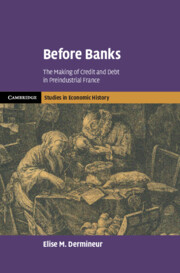Book contents
- Before Banks
- Cambridge Studies in Economic History – Second Series
- Before Banks
- Copyright page
- Dedication
- Contents
- Figures
- Tables
- Acknowledgements
- Currency and Surface
- Introduction
- 1 The Setting: Mutual Arrangements in Small Communities in the South of Alsace 1650–1790
- 2 Peer-to-Peer Lending in Non-intermediated Credit Markets
- 3 Intermediated Credit: Notarial Contracts
- 4 Women and Credit
- 5 Insolvency and Default
- 6 The Growing Institutionalization of Credit
- Epilogue: The Community of Advantage
- Bibliography
- Index
- References
Bibliography
Published online by Cambridge University Press: 27 June 2025
- Before Banks
- Cambridge Studies in Economic History – Second Series
- Before Banks
- Copyright page
- Dedication
- Contents
- Figures
- Tables
- Acknowledgements
- Currency and Surface
- Introduction
- 1 The Setting: Mutual Arrangements in Small Communities in the South of Alsace 1650–1790
- 2 Peer-to-Peer Lending in Non-intermediated Credit Markets
- 3 Intermediated Credit: Notarial Contracts
- 4 Women and Credit
- 5 Insolvency and Default
- 6 The Growing Institutionalization of Credit
- Epilogue: The Community of Advantage
- Bibliography
- Index
- References
Information
- Type
- Chapter
- Information
- Before BanksThe Making of Credit and Debt in Preindustrial France, pp. 248 - 274Publisher: Cambridge University PressPrint publication year: 2025
